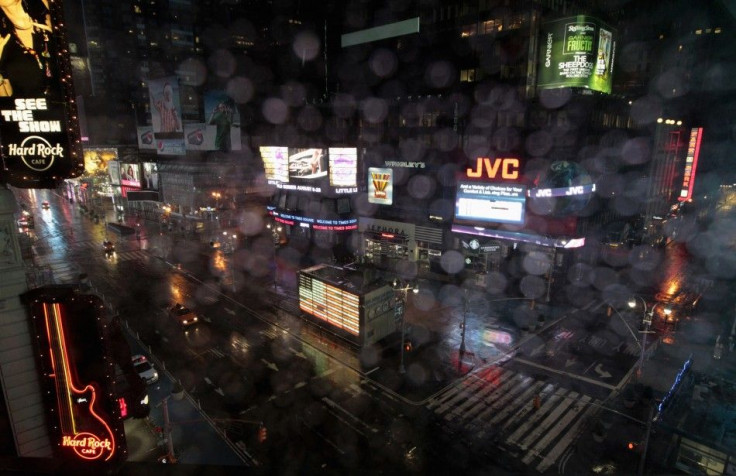Hurricane Irene Path 2011: New York Dodges Bullet, But 3 Million on East Coast Without Power

New York may have dodged a big bullet as Hurricane Irene weakened early Sunday, but America's largest city and the surrounding area in particular didn't dodge major impact from the storm's path and might.
Hurricane Irene had weakened to a tropical storm when it made landfall in New York City, with winds of 65 miles per hour. One hour earlier the storm had taken a toll on New Jersey and Long Island, knocking out power for most, downing big trees, and causing flooding in the areas. The precise landfall of Hurricane Irene has not officially been determined, however.
Officials said they will make that determination through analysis later, according to the National Weather Service.
A storm surge of 3.8 feet was reported in New York Harbor, increasing total water levels to 8.6 feet, or moderate-stage flooding. Battery Park City in lower Manhattan received the brunt of that, but the damage was less than what officials had forecast as possibility for Manhattan's lowest-lying areas.
Hurricane Irene made its first landfall Saturday on North Carolina's Outer Banks, becoming the first hurricane to make U.S. landfall since Ike in 2008. Power was knocked out to more than one million homes and businesses in the Carolinas, Virginia and Maryland and the Philadelphia area experienced widespread flooding.
In all, more than three million are left without power along Irene's wake by Sunday, as the tropical storm continues up the East Coast.
Eleven people have died related to the storm.
When Hurricane Irene made landfall on Long Island, its strength was likely between Category 1 and Category 2, officials said.
Some are already estimating Hurricane Irene could become the most damaging storm to strike the New York area since Hurricane Gloria in 1985, with potential damage soaring above $15 billion.
Tornadoes were reported associated with the storm in Delaware and Virginia, damaging homes. Tornado warnings were
issued early Sunday morning for Brooklyn and Queens, New York, but officials haven't been able to confirm yet if damage is associated with touchdowns. Also, Brooklyn experienced heavy flooding in some areas.
A spokeswoman for Nassau County, said Long Beach, a Long Island city, may have experienced storm surge six to 10 feet above normal. Long Beach is about 35 miles from Manhattan.
One report from Millburn, New Jersey Sunday morning said streets in the city's downtown area experienced major flooding from the storm when the Rahway River overflowed, cascading over banks. One resident said water was moving between buildings in parts of downtown Millburn.
In New York's lower Manhattan, the Hudson River overflowed, spilling onto jogging paths and into a nearby apartment building.
At daybreak there were no major signs of massive flooding in the city in low-lying areas officials were warned about, but some power is out and Irene is not done yet. High tide is at 8 a.m., and that is expected to be the moment lower Manhattan can cross the point of knowing whether it will face storm surge flooding or not. But just before 8, it isn't appearing likely that lower Manhattan will experience mass flooding.
The worst of the storm for New York was likely when the outer bands hit the city as Irene, back in the Atlantic after making landfall in North Carolina Saturday, began to push back ashore in New Jersey. Just before 4 a.m. Sunday the National Weather Service warned that tornadoes were a possibility in parts of greater New York City. Residents of Brooklyn and Queens were urged to take shelter.
Between 4 a.m. and 5 a.m., New York area residents experienced the strongest wind gusts, as trees bent, debris flew, windows rattled and some buildings shook in wind gusts for 40 and up to 50 miles per hour. The gusts were accompanied by a driving rain, which still hasn't let up.
New York has been in a virtual shutdown since Saturday at noon. In an unprecedented move, the city closed transit systems, including subways, and issued mandatory evacuation orders for residents of low-lying areas, including Lower Manhattan. It's still too early for officials to say if subways will be reopened Monday.
At a late-night news briefing with media on the storm, Bloomberg addressed two kayakers who had to be rescued from roaring surf off Staten Island after they sought to thrill-seek in the billowing waves caused by the storm Saturday evening.
Why they were out there ... I don't know, Bloomberg said. It's cute to say I was outside during the storm, but you're much better off staying inside and looking out, said a visibly exhausted Bloomberg who stumbled over his words several times and even seemed to struggle to remember Irene's name at one point. Hurricane, he said, before pausing and adding, uh... Irene.
Irene, the first hurricane of the 2011 Atlantic season and the first to make U.S. landfall since Ike in 2008, ravaged the coast of North Carolina and Virginia on Saturday, and eight deaths have been reported from the storm so far. Many towns along the coast have been flooded and power has been knocked out from North Carolina and Virginia and New Jersey to more than two million homes and businesses.
© Copyright IBTimes 2024. All rights reserved.





















